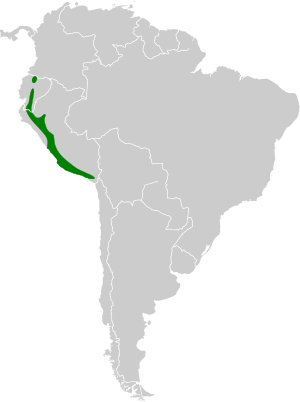Purple-collared woodstar facts for kids
Quick facts for kids Purple-collared woodstar |
|
|---|---|
 |
|
| Conservation status | |
| Scientific classification | |
| Genus: |
Myrtis
|
| Species: |
fanny
|
 |
|
| Distribution of Myrtis fanny | |
The purple-collared woodstar (Myrtis fanny) is a tiny, colorful hummingbird. It belongs to a group of hummingbirds called "bee hummingbirds." You can find this bird in the countries of Ecuador and Peru.
Contents
About the Purple-collared Woodstar
Scientists group living things together to understand them better. This is called taxonomy. The purple-collared woodstar is the only bird in its special group, or genus, called Myrtis. It seems to be a close relative of the amethyst woodstar.
There are two types, or subspecies, of the purple-collared woodstar:
- M. f. fanny (the main type)
- M. f. megalura
What Does It Look Like?
The purple-collared woodstar is a small bird, about 7.5 to 8 centimeters (3 inches) long. It weighs only about 2.3 to 2.5 grams, which is less than a penny!
Both male and female birds have:
- A short, black bill that curves downwards.
- Shiny bronze-green feathers on their backs.
Male birds are very striking:
- They have a bright, shimmering aquamarine (blue-green) patch on their throat, called a gorget.
- Below this, there's a shiny violet band.
- Their bellies are a dull white color.
- Their long, forked tail is dark brown with a light green shine.
Female birds look a bit different:
- Their bellies are a light, yellowish-brown color.
- They have a little bit of white on their throat and belly.
- Their tail is short and rounded. The middle feathers are blue-green, and the outer feathers are black with white tips.
The M. f. megalura subspecies looks just like the other one, but it has a longer tail.
Where It Lives and Its Home
The main type of purple-collared woodstar (M. f. fanny) lives in western and southern Ecuador. It also lives in western Peru, going as far south as the Arequipa area.
The M. f. megalura subspecies is found in northern Peru. It lives from the Cajamarca area south to Huánuco.
These birds like open places such as:
- Dry coastal scrub (bushes near the sea).
- Open woodlands (forests with space between trees).
- Gardens (yes, they visit human gardens!).
They can live from sea level up to about 3,000 meters (9,800 feet) high. In Ecuador, they are usually found between 1,000 and 2,000 meters (3,300 to 6,600 feet) high.
How It Behaves
Movement
Scientists are not sure if purple-collared woodstars move around a lot. It's possible they move up and down mountains depending on the season or food.
Feeding
The purple-collared woodstar mostly eats nectar from flowers. It flies a special path, visiting many different flowering plants in a circle. This is called "trap-lining." It also catches small insects while flying to get more nutrients.
Reproduction and Life Cycle
Purple-collared woodstars breed at different times depending on where they live:
- In Ecuador, they breed from March to June.
- In Peru, they breed from June to October.
When a male wants to attract a female, he flies in a special semicircular (half-circle) pattern.
The female builds a tiny cup-shaped nest. She uses plant fibers and spiderwebs to make it strong. She usually places the nest in a thin tree branch, about 2 to 4 meters (6 to 13 feet) off the ground. Sometimes, the nest is even higher.
The female lays two eggs and sits on them for 15 to 16 days until they hatch. The baby birds stay in the nest for another 19 to 22 days before they are ready to fly.
Vocalization (Sounds It Makes)
Male purple-collared woodstars make different sounds:
- During their courtship flight, they make a "ti-ti-ti-trl" sound at the top of their flight.
- At the bottom of their flight, they make a "remarkable, nasal-sounding 'anh-anh-anh-anh-anh'."
- When chasing another bird, they make a fast, high-pitched, descending "ti-ti-ti-ti" sound.
- Another call they make is a fast, dry "chi-chi-chi."
Its Status in Nature
The IUCN (International Union for Conservation of Nature) checks on animals to see if they are in danger. They have said the purple-collared woodstar is of "Least Concern." This means it is not currently in danger of disappearing.
This bird lives in a large area. Even though we don't know exactly how many there are, their population seems to be stable. They are quite common where they live and are even happy to live in places changed by humans, like gardens.
See also
 In Spanish: Purple-collared woodstar para niños
In Spanish: Purple-collared woodstar para niños


